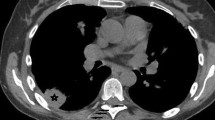Abstract
Advantages of thoracic paravertebral analgesia (TPA) include placement of the catheter closer to the surgical field; however, the catheter can become damaged during the operation. We experienced a case of intraoperative TPA catheter breakage that prompted us to perform an experiment to investigate possible causes. A 50-year-old male underwent a thoracoscopic lower lobectomy under general anesthesia with TPA via an intercostal approach. Following surgery, it was discovered that the catheter had become occluded, as well as cut and fused, so we reopened the incision and removed the residual catheter. From that experience, we performed an experiment to examine electrocautery-induced damage in normal (Portex™, Smith’s Medical), radiopaque (Perifix SoftTip™, BBraun), and reinforced (Perifix FX™, BBraun) epidural catheters (n = 8 each). Chicken meat was penetrated by each catheter and then cut by electrocautery. In the normal group, breakage occurred in 8 and occlusion in 6 of the catheters, and in the radiopaque group breakage occurred in 8 and occlusion in 7. In contrast, breakage occurred in only 3 and occlusion in none in the reinforced group, with the 5 without breakage remaining connected only by the spring coil. Furthermore, in 7 of the reinforced catheters, electric arc-induced thermal damage was observed at the tip of the catheter. A TPA catheter for thoracic surgery should be inserted via the median approach, or it should be inserted after surgery to avoid catheter damage during surgery.




Similar content being viewed by others
References
Lönnqvist PA, MacKenzie J, Soni AK, Conacher ID. Paravertebral blockade. Failure rate and complications. Anaesthesia. 1995;50:813–5.
Richardson J, Sabanathan S, Jones J, Shah RD, Cheema S, Mearns AJ. A prospective, randomized comparison of preoperative and continuous balanced epidural or paravertebral bupivacaine on post-thoracotomy pain, pulmonary function and stress responses. Br J Anaesth. 1999;83:387–92.
Davies RG, Myles PS, Graham JM. A comparison of the analgesic efficacy and side-effects of paravertebral vs epidural blockade for thoracotomy—a systematic review and meta-analysis of randomized trials. Br J Anaesth. 2006;96:418–26.
Elsayed H, McKevith J, McShane J, Scawn N. Thoracic epidural or paravertebral catheter for analgesia after lung resection: is the outcome different? J Cardiothorac Vasc Anesth. 2012;26:78–82.
Okajima H, Tanaka O, Ushio M, Higuchi Y, Nagai Y, Iijima K, Horikawa Y, Ijichi K. Ultrasound-guided continuous thoracic paravertebral block provides comparable analgesia and fewer episodes of hypotension than continuous epidural block after lung surgery. J Anesth. 2015;29:373–8.
Hara K, Sakura S, Nomura T, Saito Y. Ultrasound guided thoracic paravertebral block in breast surgery. Anaesthesia. 2009;64:223–5.
Luyet C, Eichenberger U, Greif R, Vogt A, Szücs Farkas Z, Moriggl B. Ultrasound-guided paravertebral puncture and placement of catheters in human cadavers: an imaging study. Br J Anaesth. 2009;102:534–9.
Shibata Y, Nishiwaki K. Ultrasound-guided intercostal approach to thoracic paravertebral block. Anesth Analg. 2009;109:996–7.
Krediet AC, Moayeri N, van Geffen GJ, Bruhn J, Renes S, Bigeleisen PE, Groen GJ. Different approaches to ultrasound-guided thoracic paravertebral block: an illustrated review. Anesthesiology. 2015;123:459–74.
Maniwa T, Saito Y, Kaneda H, Imamura H. Bronchial stump reinforcement with the intercostal muscle flap without adverse effects. Eur J Cardiothorac Surg. 2006;30:652–6.
Sankaranarayanan G, Resapu RR, Jones DB, Schwaitzberg S, De S. Common uses and cited complications of energy in surgery. Surg Endosc. 2013;27:3056–72.
Mariano ER, Yun RD, Kim TE, Carvalho B. Application of echogenic technology for catheters used in ultrasound-guided continuous peripheral nerve blocks. J Ultrasound Med. 2014;33:905–11.
Mitra R, Fleischmann K. Management of the sheared epidural catheter: is surgical extraction really necessary? J Clin Anesth. 2007;19:310–4.
Lenox WC, Kost-Byerly S, Shipley R, Yaster M. Pediatric caudal epidural catheter sequestration: an unusual complication. Anesthesiology. 1995;83:1112–4.
Kim TH, Shin JJ, Lee WY. Surgical treatment of a broken neuroplasty catheter in the epidural space: a case report. J Med Case Rep. 2016;10:277.
Ugboma S, Au-Truong X, Kranzler LI, Rifai SH, Joseph NJ, Salem MR. The breaking of an intrathecally-placed epidural catheter during extraction. Anesth Analg. 2002;95:1087–9.
Acknowledgements
We thank Smith’s Medical and BBraun for providing the catheters used in the experiment.
Author information
Authors and Affiliations
Corresponding author
Ethics declarations
Conflict of interest
The authors have no competing interests to declare.
Informed consent
Written informed consent was obtained from the patient and his family to publish this case report and accompanying images, a copy of which has been submitted to the editor.
About this article
Cite this article
Saeki, N., Sugimoto, Y., Mori, Y. et al. Paravertebral block catheter breakage by electrocautery during thoracic surgery. J Anesth 31, 463–466 (2017). https://doi.org/10.1007/s00540-017-2361-z
Received:
Accepted:
Published:
Issue Date:
DOI: https://doi.org/10.1007/s00540-017-2361-z




